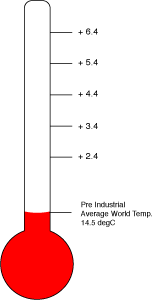
0 — Pre industrial average world temperature, 14.5degC
move your mouse up and down the thermometre to find out more
move your mouse up and down the thermometre to find out more

|
0 — Pre industrial average world temperature, 14.5degC
move your mouse up and down the thermometre to find out more |

GtC = Giga tonne of Carbon emissions
Giga = 1billion
| Year | Total World GtC/yr | Average world KgC/Person yr | World average as % of 2005 Australian per person emission |
| 2010 | 8 | 1230 | 16.7% |
| 2034 | 4 | 615 | 8.3% |
| 2050 | 3.128 | 480 | 6.5% |
| 2100 | 0.4 | 61.5 | 0.83% |

